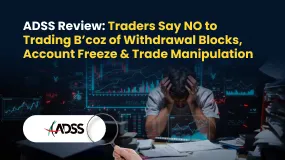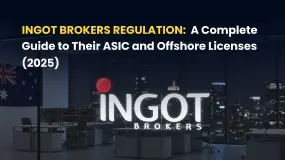简体中文
繁體中文
English
Pусский
日本語
ภาษาไทย
Tiếng Việt
Bahasa Indonesia
Español
हिन्दी
Filippiiniläinen
Français
Deutsch
Português
Türkçe
한국어
العربية
Mastering Support and Resistance in Forex Trading Success
Abstract:Know why support and resistance levels are crucial in Forex trading, the best tools to identify them, and how they impact trading success.

Understanding Support and Resistance in Forex Trading
Forex trading is fast-paced, and keeping ahead requires mastering fundamental ideas that may make or break your performance. Support and resistance levels, the unseen battle lines where buyers and sellers collide, are one of the most essential instruments used by traders. These aren't simply random dots on a graph; they represent market psychology and can help forecast where prices will move next.
Support and resistance levels indicate price locations where the market has previously halted or reversed. Support is the level at which purchasing demand is strong enough to keep prices from dropping further, whereas resistance is the level at which selling pressure prevents prices from increasing. These levels are important because they provide traders with critical information about when to enter or leave deals, manage risk, and make better decisions.
Why Support and Resistance Levels are Important
So, why are these figures so significant? Because they convey market emotion. When prices reach a support level, it indicates that buyers are moving in, feeling the price is low enough to be a good value. On the other hand, as prices approach a resistance level, sellers begin to take profits, believing the price is excessively high. Understanding these fluctuations allows traders to predict whether a trend is strong or likely to reverse.
Another critical notion is role reversal. When a support level is violated, it frequently transitions into resistance—and vice versa. This happens because traders' perceptions of the price level shift. What was formerly considered a purchasing opportunity may now be perceived as a selling zone, causing market behavior to alter.
Beyond technical analysis, it is critical to comprehend the psychology underlying support and resistance. These levels are influenced by more than just historical data; they represent traders' emotions—fear, greed, and the herd mentality. Recognizing these characteristics enables traders to better forecast market swings and avoid frequent errors.

Best Tools for Detecting Support and Resistance Levels
Finding support and resistance levels requires a combination of technical tools and market knowledge. One of the most basic techniques is to draw horizontal lines at previous highs and lows, which frequently serve as psychological barriers where prices rebound or breakthrough. Trendlines are also useful for indicating the market's general direction by connecting a succession of highs or lows. When these techniques are integrated, they provide a fuller picture of potential support and resistance zones.
Moving averages is another effective technique. A moving average smoothes out price volatility to reveal patterns. When prices stay above a moving average, they frequently serve as support. When they go below that level, it might function as resistance. The 200-day moving average is very popular among traders for identifying long-term trends.
Fibonacci retracement levels are another popular technique. These levels, based on the Fibonacci sequence, help identify where prices may pull back before continuing in their original course. Traders frequently examine the 38.2%, 50%, and 61.8% levels for potential support and resistance.
However, support and resistance are not exact figures; rather, they represent zones where price movements are likely to occur. This is why it is critical to employ other indicators such as volume and momentum oscillators to confirm whether a level is robust. Volume, in particular, can give important clues—high volume near a support or resistance level indicates substantial buying or selling activity, increasing the likelihood of a reversal.
One of the most common mistakes that traders make is leaning too much on support and resistance levels without taking into account the wider picture. While these levels are useful, they should be coupled with other forms of research, such as fundamental analysis and market news. A significant economic report or unforeseen event might overturn technical levels and send the market in an entirely opposite path.
Managing Risk with Support and Resistance
Risk management is a critical component of trading using support and resistance levels. Even the most stable levels can fail, therefore traders should always employ stop-loss orders and position size to limit possible losses. A decent rule of thumb is to set a stop loss somewhere below or above support, allowing for market movements while reducing risk.
Final Thoughts
Forex traders rely heavily on support and resistance levels. They give insights into the market mood, aid in determining entry and exit locations, and serve as the cornerstone for risk management. Traders may improve their ability to navigate the Forex market by combining technical analysis with an awareness of market psychology and macro trends.
Learning to master support and resistance, like any other approach, requires practice and constant improvement. Markets change, and so should your attitude. The key to long-term success is to remain adaptable and prepared for change—because, at the end of the day, “the market is always right.”

Disclaimer:
The views in this article only represent the author's personal views, and do not constitute investment advice on this platform. This platform does not guarantee the accuracy, completeness and timeliness of the information in the article, and will not be liable for any loss caused by the use of or reliance on the information in the article.
Read more

Grand Capital Doesn’t Feel GRAND for Traders with Withdrawal Denials & Long Processing Times
The trading environment does not seem that rosy for traders at Grand Capital, a Seychelles-based forex broker. Traders’ requests for withdrawals are alleged to be in the review process for months, making them frustrated and helpless. Despite meeting the guidelines, traders find it hard to withdraw funds, as suggested by their complaints online. What’s also troubling traders are long processing times concerning Grand Capital withdrawals. In this Grand Capital review segment, we have shared some complaints for you to look at. Read on!

ADSS Review: Traders Say NO to Trading B’coz of Withdrawal Blocks, Account Freeze & Trade Issues
Does ADSS give you plenty of excuses to deny you access to withdrawals? Is your withdrawal request pending for months or years? Do you witness account freezes from the United Arab Emirates-based forex broker? Do you struggle to open and close your forex positions on the ADSS app? Does the customer support service fail to respond to your trading queries? All these issues have become a rage online. In this ADSS Broker review article, we have highlighted actual trader wordings on these issues. Keep reading!

INGOT Brokers Regulation 2025: ASIC vs Offshore License - What Traders Must Know
Explore INGOT Brokers regulation in 2025: Compare their ASIC and Seychelles FSA licenses, understand trader protection levels, and learn about potential risks in this detailed guide.

INGOT Brokers Review 2025: High Risk or Hidden Gem? Expert Analysis Reveals All
Comprehensive INGOT Brokers review exploring the broker's mixed reputation in 2025. Discover the truth about regulation, trading options, and user experiences before opening an account.
WikiFX Broker
Latest News
Mitrade Arabic Platform Targets MENA Gold Trading Boom
Israeli Arrested in Rome Over €50M Forex Scam
New FCA Consumer Alert 2025: Important Warning for All Consumers
EmiraX Markets Withdrawal Issues Exposed
Global Guide to Finding Forex IBs/Brokers — Share Your Pick and Win Big!
Consob Targets Political Deepfake “Clone Sites” and Unlicensed Platforms in Latest Enforcement Round
WikiEXPO Global Expert Interviews: Gustavo Antonio Montero: ESG in Finance
Trump tariffs are helping drive U.S. beef prices to new highs
Scam Alert: GINKGO-my.com is Draining Millions from Malaysians!
Trading Pro Review: Scam Broker Exposed
Currency Calculator



